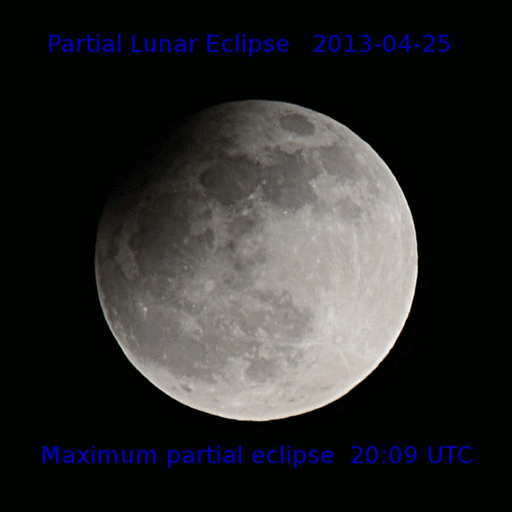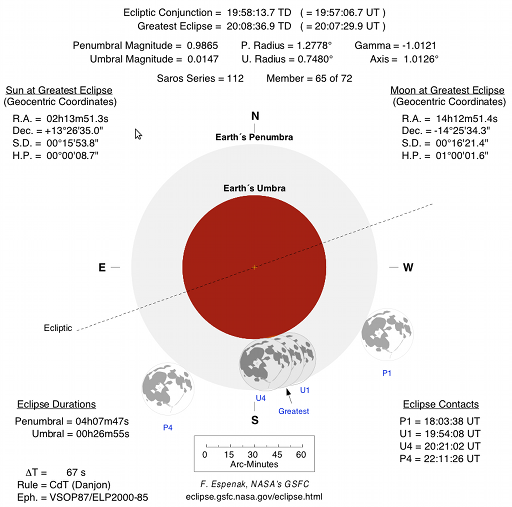« Reading List: Escape from Camp 14 | Main | Reading List: Inferno »
Tuesday, May 21, 2013
Partial Lunar Eclipse: 2013-04-25

Click image to enlarge.
On the evening of April 25th, 2013, a close to minimal partial eclipse of the Moon occurred for observers in the Eastern Hemisphere. Only 1.5% of the Moon/s disc was completely within the Earth's shadow (the umbra—where observers on that part of the Moon would see the Sun completely obscured by the Earth); the rest of the Moon experienced only a penumbral eclipse: observers there would see only a partial eclipse of the Sun by the Earth. The following graphic illustrates the geometry of this eclipse. I began the photo sequence above near the maximum partial eclipse. Due to my location, the eclipse was already in progress when the Moon rose, so it wasn't possible to record the entire eclipse from Fourmilab Observatory (otherwise known as my driveway). I was only able to photograph the second half of the event. As you can see from the geometry graphic, at the moment of maximum partial eclipse, only a tiny nibble of the Moon's disc was inside the umbra, but almost the entire Moon was within the penumbra. When the partial phase ended, little had changed: the penumbral shading of the disc was almost the same. At the conclusion of the eclipse, with the Moon entirely outside the Earth's shadow, its disc was much brighter (so much, in fact, that the image verges on being overexposed—I should have used a faster shutter speed for the images taken during the partial and penumbral phases of the eclipse). For consistency and to render the images directly comparable, all were taken at f/8 with a 1/30th second shutter speed at ISO 100 by a Nikon D600 camera with a 25 year old NIKKOR 300 mm f/4.5 lens. All post-processing of the images preserved the relative intensities of the the originals. The bulk of image processing was done with The Gimp, and automatic alignment of the images was done with Photoshop CS4.
“Seeing” (atmospheric turbulence and transparency) varied substantially in the period these images were taken—the Moon was rising and the sky, while cloudless, was a bit murky. I have applied different degrees of sharpening to these images to compensate, but it remains apparent if you look closely. None of the image processing I did adjusted the intensities captured by the camera's sensors—they are faithful to what the camera saw, although not necessarily what human observers would have perceived looking at the same scene with their nonlinear vision.
I began the photo sequence above near the maximum partial eclipse. Due to my location, the eclipse was already in progress when the Moon rose, so it wasn't possible to record the entire eclipse from Fourmilab Observatory (otherwise known as my driveway). I was only able to photograph the second half of the event. As you can see from the geometry graphic, at the moment of maximum partial eclipse, only a tiny nibble of the Moon's disc was inside the umbra, but almost the entire Moon was within the penumbra. When the partial phase ended, little had changed: the penumbral shading of the disc was almost the same. At the conclusion of the eclipse, with the Moon entirely outside the Earth's shadow, its disc was much brighter (so much, in fact, that the image verges on being overexposed—I should have used a faster shutter speed for the images taken during the partial and penumbral phases of the eclipse). For consistency and to render the images directly comparable, all were taken at f/8 with a 1/30th second shutter speed at ISO 100 by a Nikon D600 camera with a 25 year old NIKKOR 300 mm f/4.5 lens. All post-processing of the images preserved the relative intensities of the the originals. The bulk of image processing was done with The Gimp, and automatic alignment of the images was done with Photoshop CS4.
“Seeing” (atmospheric turbulence and transparency) varied substantially in the period these images were taken—the Moon was rising and the sky, while cloudless, was a bit murky. I have applied different degrees of sharpening to these images to compensate, but it remains apparent if you look closely. None of the image processing I did adjusted the intensities captured by the camera's sensors—they are faithful to what the camera saw, although not necessarily what human observers would have perceived looking at the same scene with their nonlinear vision.
Posted at May 21, 2013 23:17